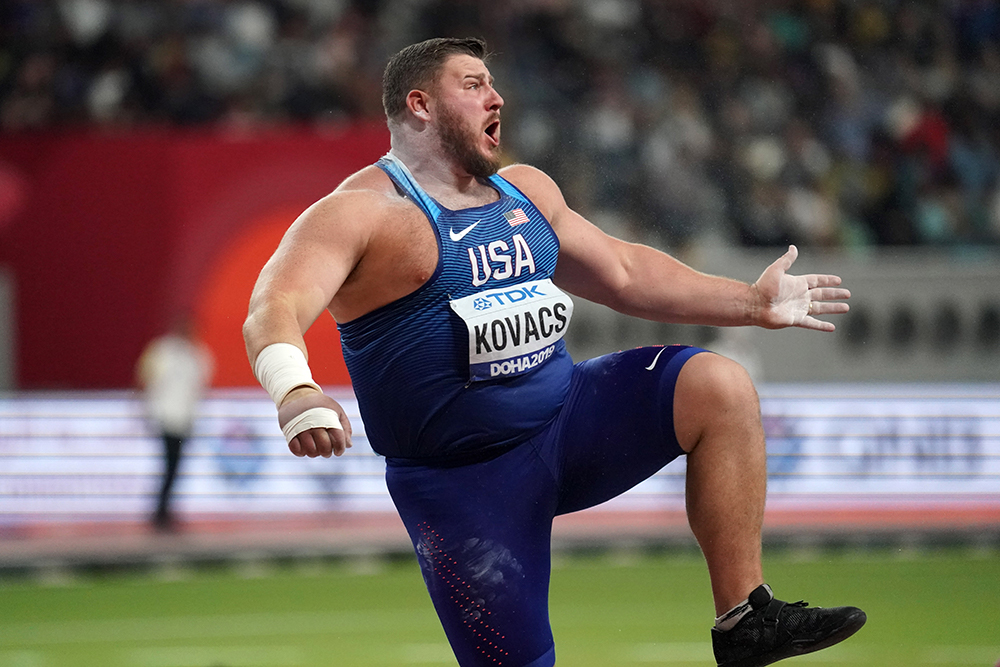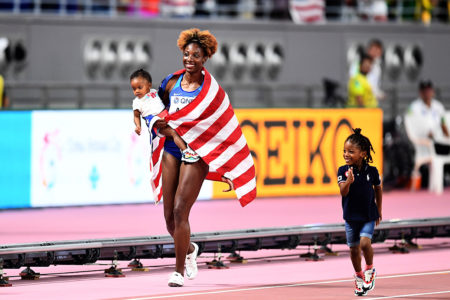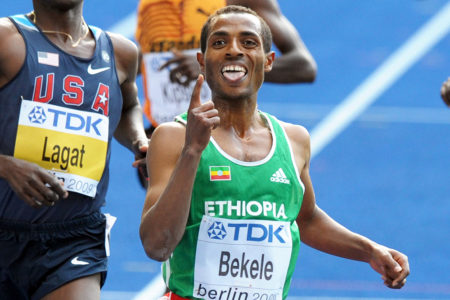
WHAT NEEDS to align to win history’s greatest shot competition ever? (Or maybe, as silver medalist Ryan Crouser suggested after the World Championships event, “It could have been the greatest field event or track & field competition in history.”) In Doha the top 3 finished just a single centimeter—less than a half-inch—apart. Above 75-feet for all: 75-2 (22.91) for Joe Kovacs and 75-1¾ (22.90) for silver medalist Ryan Crouser and bronze man Tom Walsh.
Kovacs jumped up spectacularly from 4th on his last throw on the strength of both the expression he wore and the attitude he carried as he stepped into the ring. “These guys probably know I thought I only throw far angry,” he said after claiming the second world title of his career despite being only No. 7 on our premeet formchart. “This is probably the first time I ever threw far with a smile on my face. I threw pretty far today with a smile so it’s trying out something new. I thank her for that.” The woman who put the grin on Kovacs’s mug is his wife Ashley, not only his soulmate but also his coach for the past 2 years.
Said Crouser, smiling himself but also shaking his head at the outcome of Doha’s delightfully hard-fought iron ball comp, “This is years and years for all of us, and so you’re training, most of us, 5–6 days a week for anywhere from 2 to 6 hours a day. So there’s a lot of time that goes into that 1 or 2 seconds in the ring.”
Time is not all that went into it for Kovacs. Nor for Crouser, Walsh or anyone in that honored-to-have-witnessed clash. But the gold medalist’s story elevates the astounding physical to the human, stuff we can all relate to, a matter of the heart. After winning the ’15 Worlds, then pocketing silvers at the Rio Olympics and the ’17 WC, he packed up his life in Southern California—where he had been coached by venerated throws guru Art Venegas—and relocated to Ohio to join his girlfriend, Ashley Muffet. A collegiate shot/discus All-America at Kentucky, she was ensconced in her current job as Ohio State throws coach by the time Kovacs followed his heart back east. Soon she would have a world-class pupil, Kovacs, and in Doha’s red-hot final their collaboration made all the difference.
“I didn’t move to Ohio to have Ashley coach me. I moved to her because I wanted to be with her and marry her,” Kovacs explained after his PR by 13 inches (34cm) on the last try he’d get carried him to the podium top. Raising his left hand with a smile to show the media the ring on his third finger, he told his tale:
“When you talk about my wife Ashley—Kovacs now, we put a ring on it—she’s my wife and she’s coaching me now, which brings probably more stress on her than in a normal relationship. But to be honest, it’s been amazing. We don’t have a weird relationship; we don’t always talk about the shot put at home, but I think it’s a huge advantage because she’s with me every moment every day. She knows when I’m up, she knows when I’m down, she knows when I’m struggling.
“I think probably our biggest struggle was when I first moved to Ohio and the transition of her not wanting to say that much, thinking I knew it, thinking I knew that I knew what to do. I was a world champion at that time, I was already an Olympic medalist, he knows what he’s doing—that he knows he knows what he’s doing. Then she found out very quickly that wasn’t true. So in that transition of her, she’s a great coach, she’s had an NCAA champion [weight thrower Sade Olatoye last March], coached a couple 20-meter [65-foot] guys. She knows what she’s talking about, but once she started to realize that I did want feedback from her and I was going to listen—and that was probably a bigger factor than anything—once that started to mesh and that started to work, it’s been absolutely amazing for our relationship. It’s been amazing for the coach–athlete relationship and I couldn’t be happier every single day. That’s what I’m thinking about at this moment more than anything.”
Having put up 22m-plus seasonal bests 4 years in a row starting with his 72-3½ (22.03) USATF win in ’14, Kovacs saw his distances take a tumble last year. He explained that, saying, “I made a lot of changes technically, which I don’t do anymore but it was a good experiment. But I wasn’t throwing far. But it did make me change my perspective on things. I was super-excited to get married. That was the best thing that ever happened in my life, but my throwing wasn’t going very well. And leading up to the indoor season this year I finally got back into my groove. I was throwing 20m; I actually threw under 20m for a few competitions in the indoor season. But they were growing pains in the step-by-step of me buying into our plan, our plan that we had every single day to get better. To get first back to the level that I thought I was and now to get be better than ever.”
The Team Kovacs plan, he said, “was to stay in my lane, stay focused on my goal to come out with a personal best. Because, to be honest, I knew Tom and Ryan were going to throw really far. And they did. I knew if I kind of got caught up with that I would get more tense than intense, and I just focused to come away hopefully with a medal because I was trying to keep that streak going, but at least with a personal best. That’s all I was thinking every single throw. I’m sure my wife would have been happy if I threw farther earlier, but to be honest, every time I tried to execute that plan and every throw I felt getting closer and closer to what we were working on this past few weeks at practice.
“I’m just glad going into that last throw that I felt that relaxation that I struggle to find a lot of the time, and with that I was able to feel all of the things that technically we’re working on as well as the speed and velocity. When that ball came off my hand, to be honest, I didn’t know how far it was. I just knew it felt like everything we’ve been working on lined up. I knew that it was probably a far throw, hopefully in that PR range; before, 22.57 [74-¾] was my PR. It felt like that. I sure as heck yelled like it was a PR. But once I saw what that board showed it was shock. Not to think that I couldn’t throw that far, it was shock that it finally came together. Especially when you want it to come here.”
Dropping all the way to No. 21 on the world list in ’18, with 7 Americans ahead of his 68-11¾ (21.02), Kovacs had run up against a harsh reality about which his comments in Qatar were frank: “I’ll tell you, you cannot make a living in the U.S. being a 70-foot shot putter anymore. It’s tough. You gotta be a 22m [72-foot] guy now, and even that’s getting tougher and tougher.” The income deficit emerged as “probably the biggest stress and strain” on the Kovacs marriage, “not because it was the love of the sport, no; I love shot putting, I love it, but [the U.S. is] still good in the shot put, and very quickly once you’re out of the light, I was having a hard time getting into some track meets. And I had three medals to my name. So I saw how quickly it can turn the other way.”
Not everyone dismissed Kovacs in his down time, though. Crouser, for one, did not. “I know for Joe, he’s battled through a lot,” the Olympic champ told those listening in the Doha interview room. “There were times where a lot of people wrote him off and I kept saying, ‘Hey, he’s the only guy out there who has three medals in the last three majors.’”
In the coming Olympic season Kovacs’ dramatic win in the highest quality clash the shot put has ever produced just might earn him a few meet invitations. The timing has been right, he admitted, gold medallion draped over his Team USA jacket: “I’m just so happy it came full circle to be at this point—to be wearing a medal, let alone the gold, and to be walking home and taking [Ashley] to eat after this.”






